

Gentle Structures
Making Space Through Textiles
VALERIA MALDONADO
Gentle Structures Making Space Through Textiles
VALERIA MALDONADO












CONTENTS
05 07 09 19 51 73
PERSONAL STATEMENT
THE EVER-PRESENT DUALITIES OF SPACE
FEMINIST CONSTRUCTIONS
MATERNAL CONSTRUCTIONS
GENTLE STRUCTURES
MATERIALS
TECHNIQUES
ACKNOWLEDGMENTS 87 MANIFESTO
GRID, 2023
TENSION, 2023
WATER, 2023
WATER 2.0, 2023
SHELTER, 2023
THE CAVE, 2023
THE HUT, 2023
THE CAVE 2.0, 2023
THE TENT, 2023
THE WOMB, 2023
THE FROZEN FLEXION, 2023
THE CONTEMPORARY FOSSIL, 2023
THE FROZEN FLEXION 2.0, 2023
THE LITTLE CAVE, 2023
THE WOMB 2.0, 2023
THE COPPER HUT, 2023
THE LITTLE HUT, 2023
MOTHER CAVE, 2024
BOUNTIFUL SHELTER, 2024
SYMBIOSIS, 2024 FROM ROCK TO WATER, 2024
VEGETAL ANIMAL MINERAL FUNGI
WEAVING COILING SPRANG BASKETRY NATURAL DYES

VALERIA MALDONADO
I am a textile sculptor whose work centers on weaving’s ability to shape three-dimensional forms. Drawing from my architectural background, I am fascinated with creating self-supporting textiles, which open possibilities for unexpected structural shapes and the creation of internal space. I combine weaving, sprang, basketry, coiling, natural dyes and clay to create duality within my sculptures, often using coarse materials contrasted with delicate open grids. My Peruvian heritage informs my material approach and is centered on natural elements ranging from alpaca, “junco”, sisal rope, and rattan to clays, ochres, sand and natural dyes. These material combinations allow for structure and plasticity.
My work is both analytical and nostalgic. By inspecting themes around containment, inhabiting space, and the maternal strength of nature, I craft sculptures that portray different environments within themselves, often incorporating principles to reconfigure architecture from a feminist point of view. Simultaneously, I find myself inspired by my childhood, the earthy tones of my brick-colored apartment, my mother’s teal eyes, and the scenery of my coastal hometown in Lima. The dynamic relationship between the ocean and the rocks, and their contrasting yet complementary qualities, inspire me to explore the interplay of fluid caves and structured waters.
In my process, I’ve discovered a specific way of creating organic, fluid volumes almost in movement, a sensation that I can only get with textiles. The natural fluidity and tension I get from the fibers, combined with more rigid elements like clay or resin, result in my unique vessels. Textiles have the capacity for unexpected and almost melted volumes that appear willing to change but are strong in their point of view. My practice lies in the quest to create these specific structural yet fluid forms that I call “Gentle Structures.”
With my work, I want to challenge notions of what is flexible versus what is structured. My pieces are catalysts for thinking about how we inhabit space and envision potential transformations of our environments if we return to primordial or maternal womb-like forms.





















THE EVER-PRESENT DUALITIES OF SPACE
The interplay between our living and psychological environments is a central theme in my work, characterized by familiar gestures such as rock-like foundations, openness, grids, fluid movements, and organic shapes. Whether shaping space or crafting environments, I employ textile mediums to create space for the introspection of life. My work is rooted in the architectural spaces we inhabit through time, from the womb to the cave, the hut to the tent, and back to the vessel, my creations are containers that reflect growth and the passage of time.
As a woman capable of creating space within my body, and an architect capable of designing space, I’m fascinated with the inhabitation of space throughout humanity. As a textile artist, I’m intrigued by the historical reliance on fibers, which underscores humanity’s need to craft space from these materials for survival. As a Peruvian, I am forever allured by the coastal landscapes of my native Lima, where ocean and caves dance alongside the city, thus inspiring my reflections around water and rock as primary elements for life. After all, we are born from water and turned into dust.
From these reflections, questions arise: What does it truly mean to inhabit space? How have these physical environments shaped humanity, and what role have textiles played in their creation? How do these environments, with their reliance on natural elements, shape our habitats and the landscapes of our psychology? How do structure and flexibility serve as anchors for both sound buildings and healthy minds?
To answer these existential questions, I explore the built environment as a mirror of psychological landscapes, often juxtaposing dualities in shapes, materials, and opacity, thus conveying a sense of a grounding element -security- and an open flexible one –acceptance-. Sculptures with vessel-like forms feature prominently in my work, serving as spaces for containment or habitation—symbolizing how we learn from nature to inhabit our physical and mental worlds.
By creating textiles inspired by the the primary materials of earth and water, I craft vessels I’ve named “Gentle Structures”, that express the ever-present dualities of space: both structured and flexible, organic and geometric, soft and hard; these forms entangle preconceived notions of gender, material, and space.

FEMINIST CONSTRUCTIONS
I’m inspired by women, I’m inspired by their strong laughter, by their capacity to nurture, the immediacy in which they come to your rescue, their capacity to create in every form, their patience, and their generosity, but especially, I’m inspired by the resilience they have to thrive every single day in a world that was designed to oppress them.
Who created our cities? Who was taken into consideration while designing them? Who was given credit for doing so? I am starting a conversation, even if it is hypothetical, about the principles for designing a city made by women, a feminist city that creates space for everyone to thrive.
In my exploration of this feminist city, I created guiding principles through architectural textile sculptures or “models” that define its various facets. Shelter, water, tension, and grid serve as fundamental elements in shaping the three-dimensional environments I envision. In this way, I contemplate how we can take wisdom from the maternal strength of water and harness the feminine capacity of creation to reconfigure architecture and ways of inhabiting. SHELTER
Crafted to house both self and others, reflecting on how we occupy space.
A maternal force that allows for pliability of hard materials like rattan and clay, as well as fostering mycelium growth.
In textiles, a force often seen as subtle yet possessing remarkable strength.
Organized geometry capable of creating organic forms.


Grid
Rattan, alpaca yarn
Basketry
26” x 15” x 10”


Tension Rattan, bengala dyes, alpaca yarn, cassette tapes
Weaving 16” x 15” x 8” 2023



Mycelium, hemp cord, yarn
Weaving/Bio materials
12” x 10” x 6”

















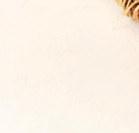







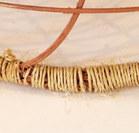

























Shelter
Rattan, bengala dyes, jute Basketry
15” x 11” x 9”

MATERNAL CONSTRUCTIONS
These vessel-like sculptures explore the intricate relationship between three-dimensional forms and the craft of weaving. Both conceptually and materially, they embody the fundamental objective of crafting structures that seamlessly blend strength with flexibility. This metaphorically reflects upon inhabited space and maternal principles, delving into a psychological framework centered on the ability to provide support and establish secure structures while embracing qualities of flexibility, tenderness, and understanding.
Drawing inspiration and wisdom from two elemental forces of nature—caves and water—the structures symbolize the enduring interplay between rigidity and pliancy. Water embodies the essence of life, fluidity, and rejuvenation, while caves signify the foundational aspects of containment, protection, and support. Together, these natural elements challenge conventional notions of what is flexible and what is hard.
Exploring the profound relationship between humanity and its environment, the vessels prompt contemplation on why our existence is intrinsically linked to our surroundings. From the womb, our primal home, to the ancient architectural prototypes of caves, huts, and tents, humanity has relied on these spaces for both physical survival and psychological well-being. These vessels encapsulate the essence of space, drawing inspiration from these four primal environments of the human experience for their creation.
Our initial environment, symbolizes the connection to water, maternal nurturing, and the act of birth.
Natural dwellings shaped by the earth; embodying wisdom drawn from the natural world.
Associated with vegetable fibers and their potential for intricate weaving.
Utilizing woven textiles and flexible structures to shape inhabitable spaces.
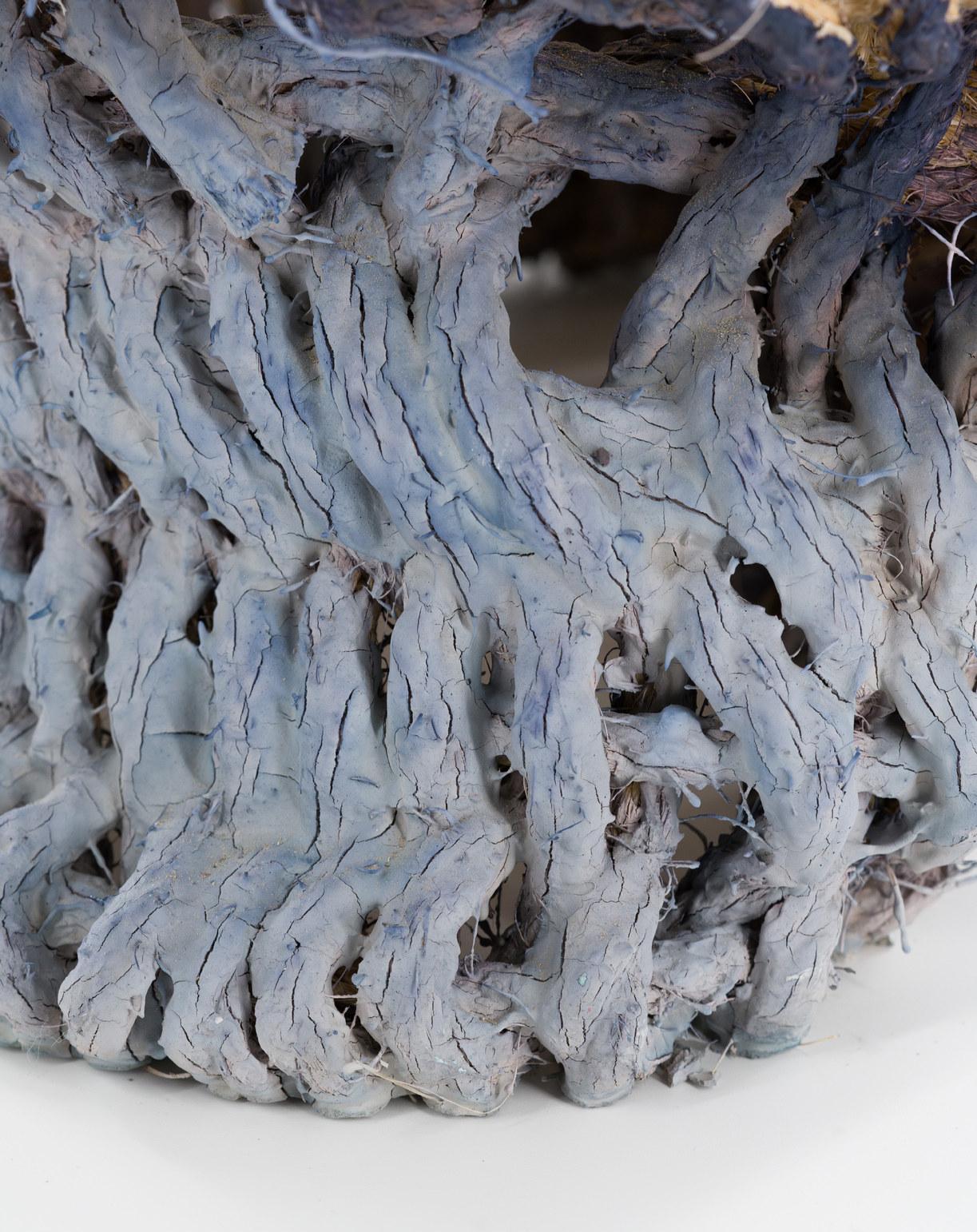

The Cave Sisal rope, clay, peaflower Weaving
13” x 16” x 10” 2023


The Hut
Sisal rope, rattan,clay, ochres
Weaving
25” x 11” x 11”

The Cave 2.0 Sisal rope, silk organza, peaflower
Weaving
19” x 15” x 7” 2023


The Tent
Peruvian Alpaca yarn, clay, spirulina, ochres Sprang
17” x 9” x 6”

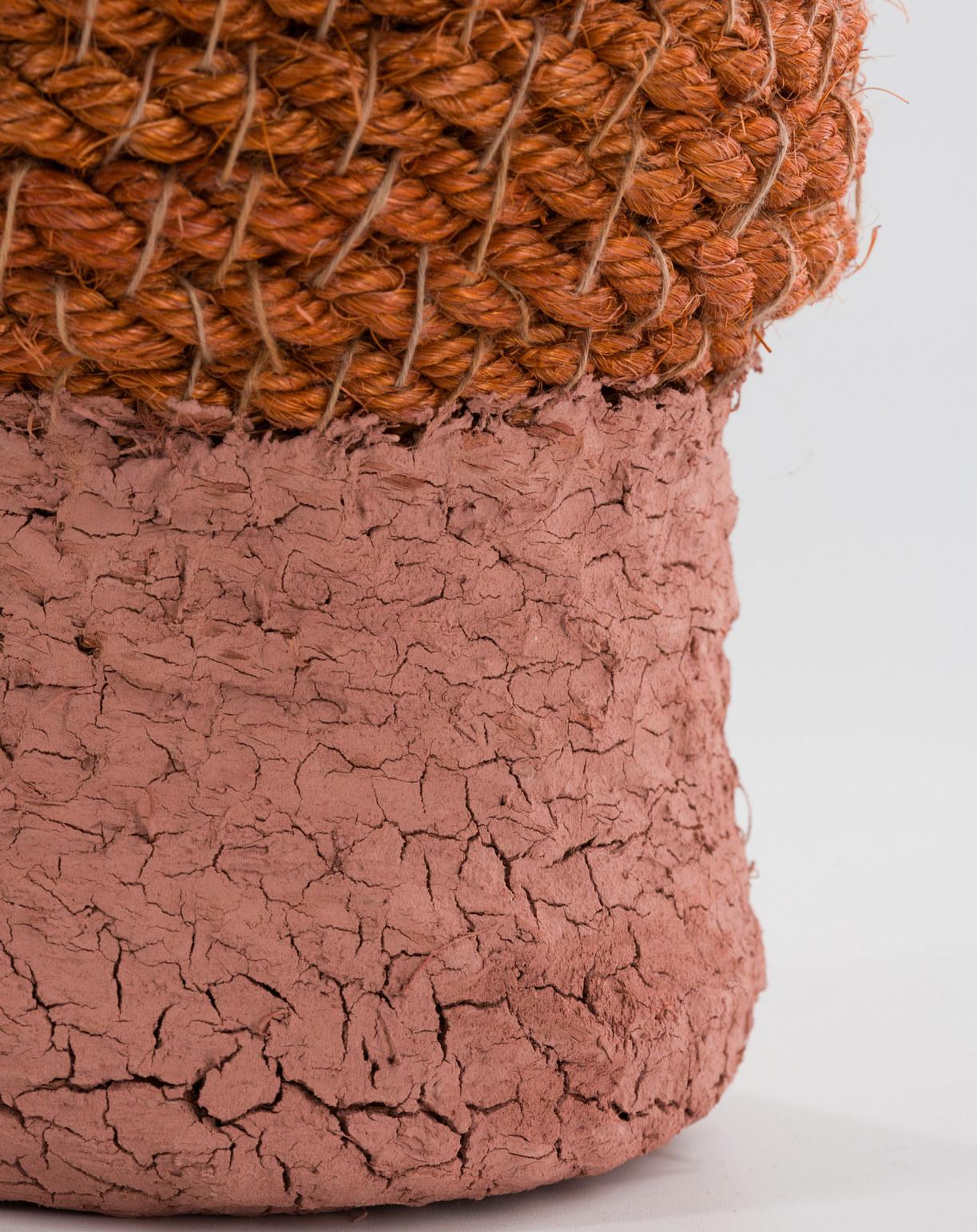

The Womb Sisal rope, clay, madder, catechu Coiling
12” x 9” x 6”


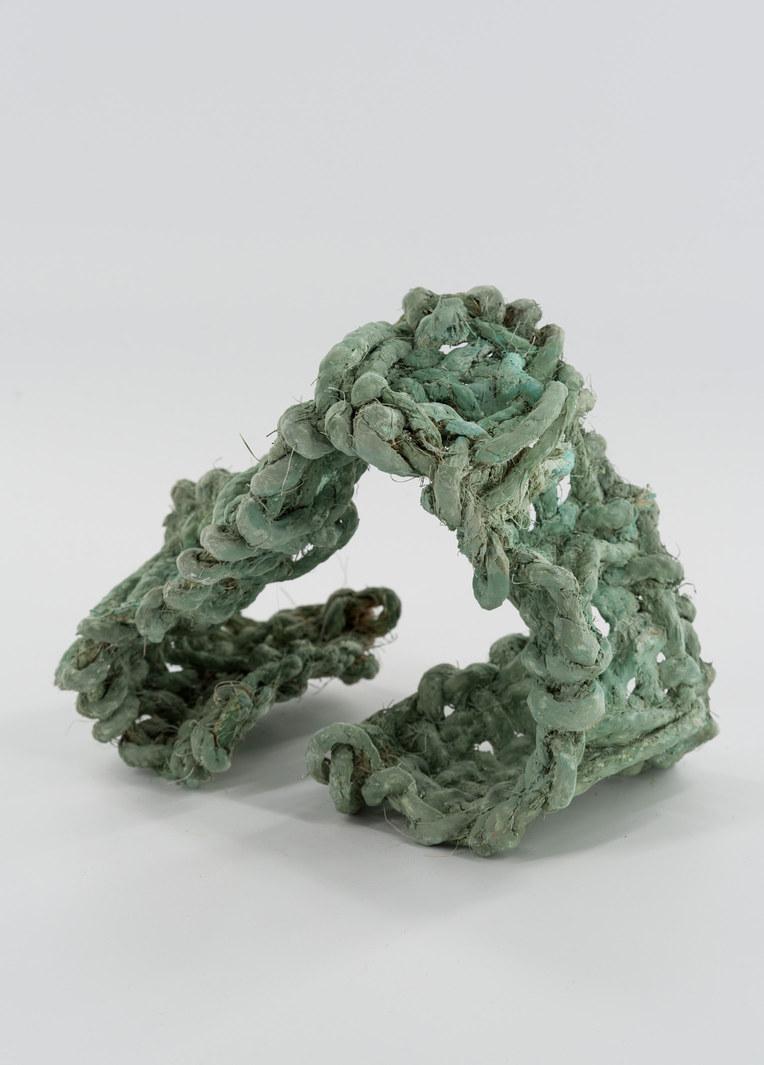
The Frozen Flexion Sisal rope, clay, ochres Weaving
10” x 8” x 6”


The Contemporary Fossil Hemp cord, peruvian alpaca yarn, clay Sprang
7” x 6” x 6”



The Frozen Flexion 2.0 Cotton rope, clay, avocado pits
Weaving
11” x 5” 2023
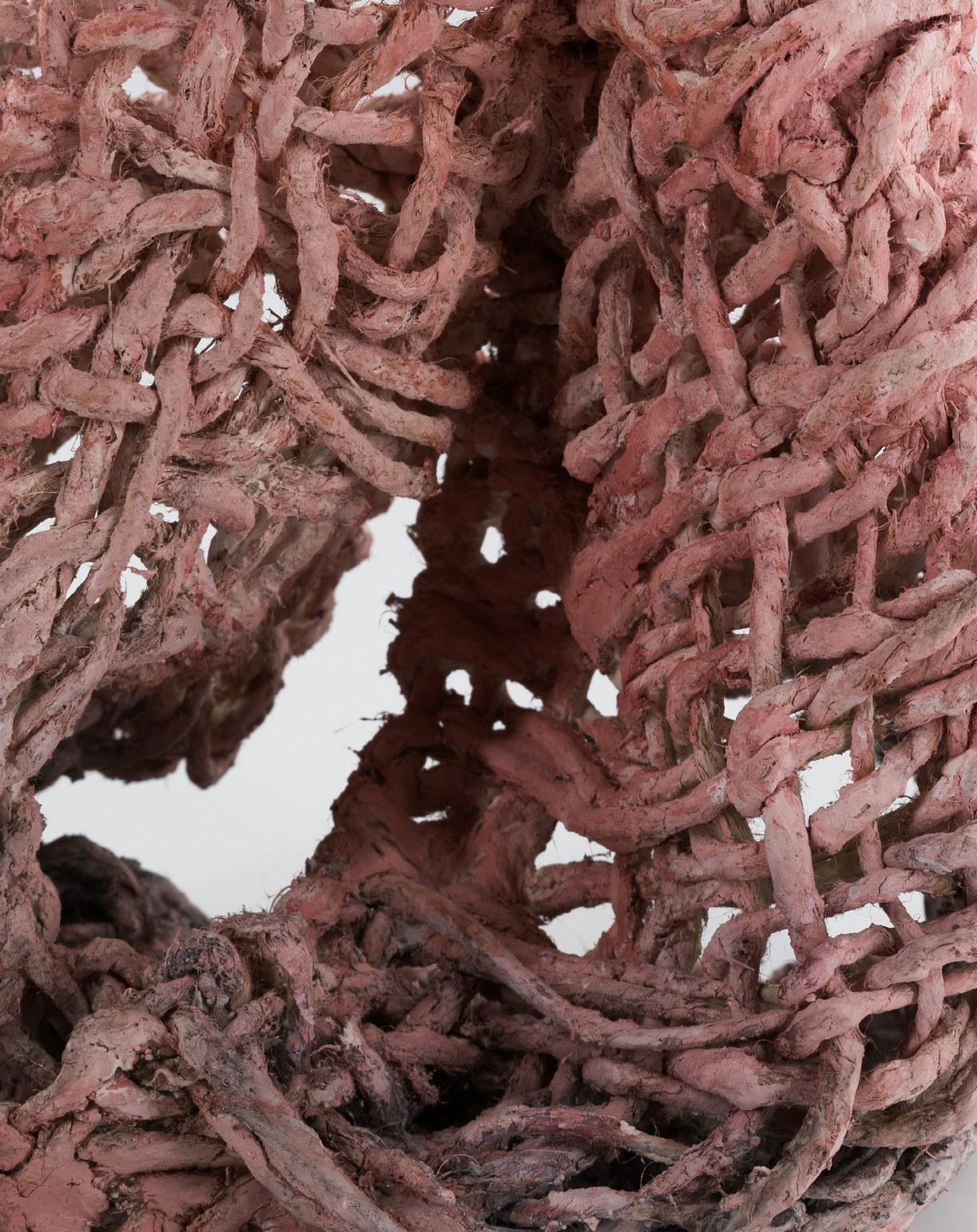

The Little Cave Hemp cord, clay, ochres Weaving
9”x 5”x 6”
2023
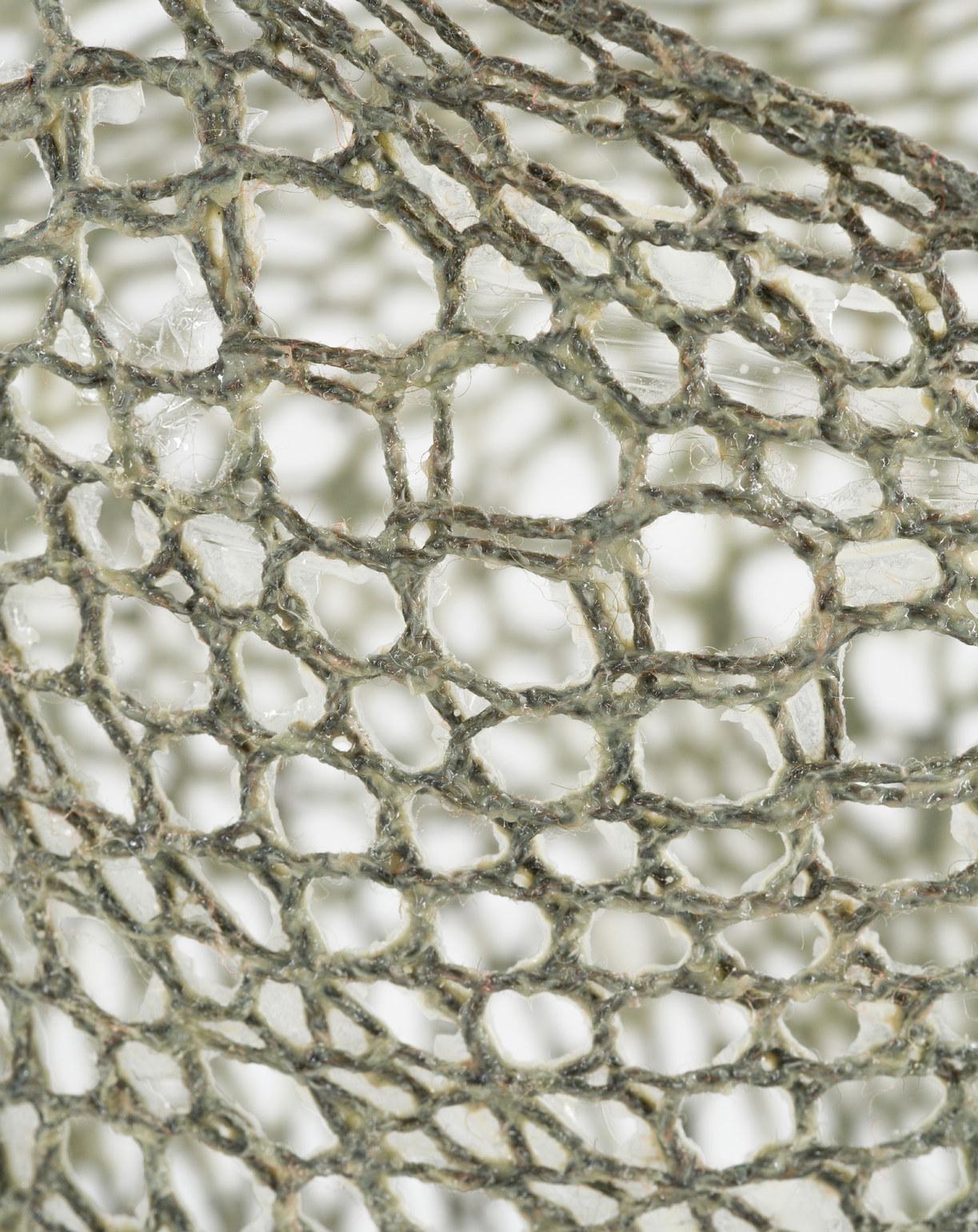

The Womb 2.0 Peruvian alpaca yarn, Bio resin Sprang
15” x 12” x 7”
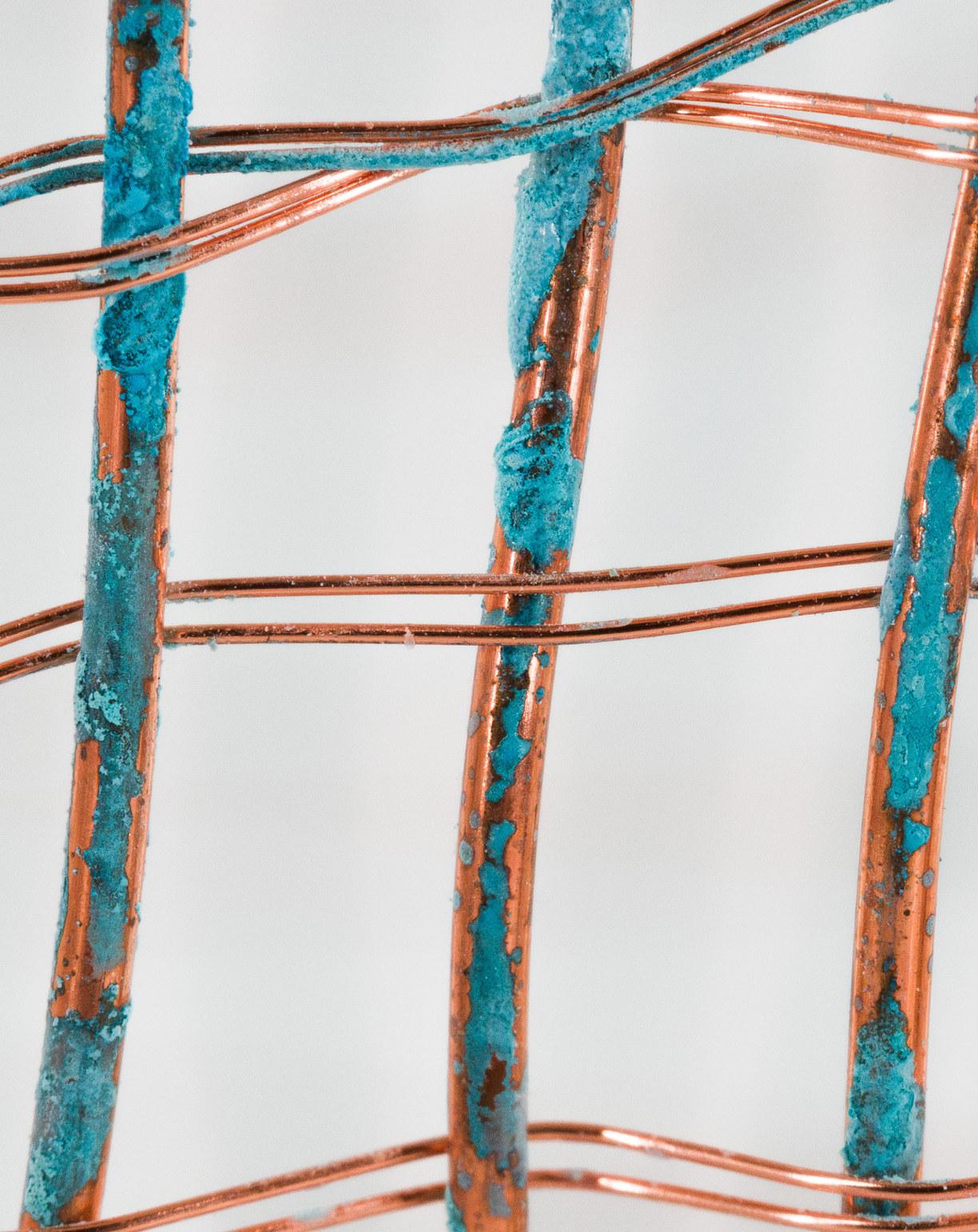

The Copper Hut Copper wire
Weaving
16” x 9” x 7” 2023
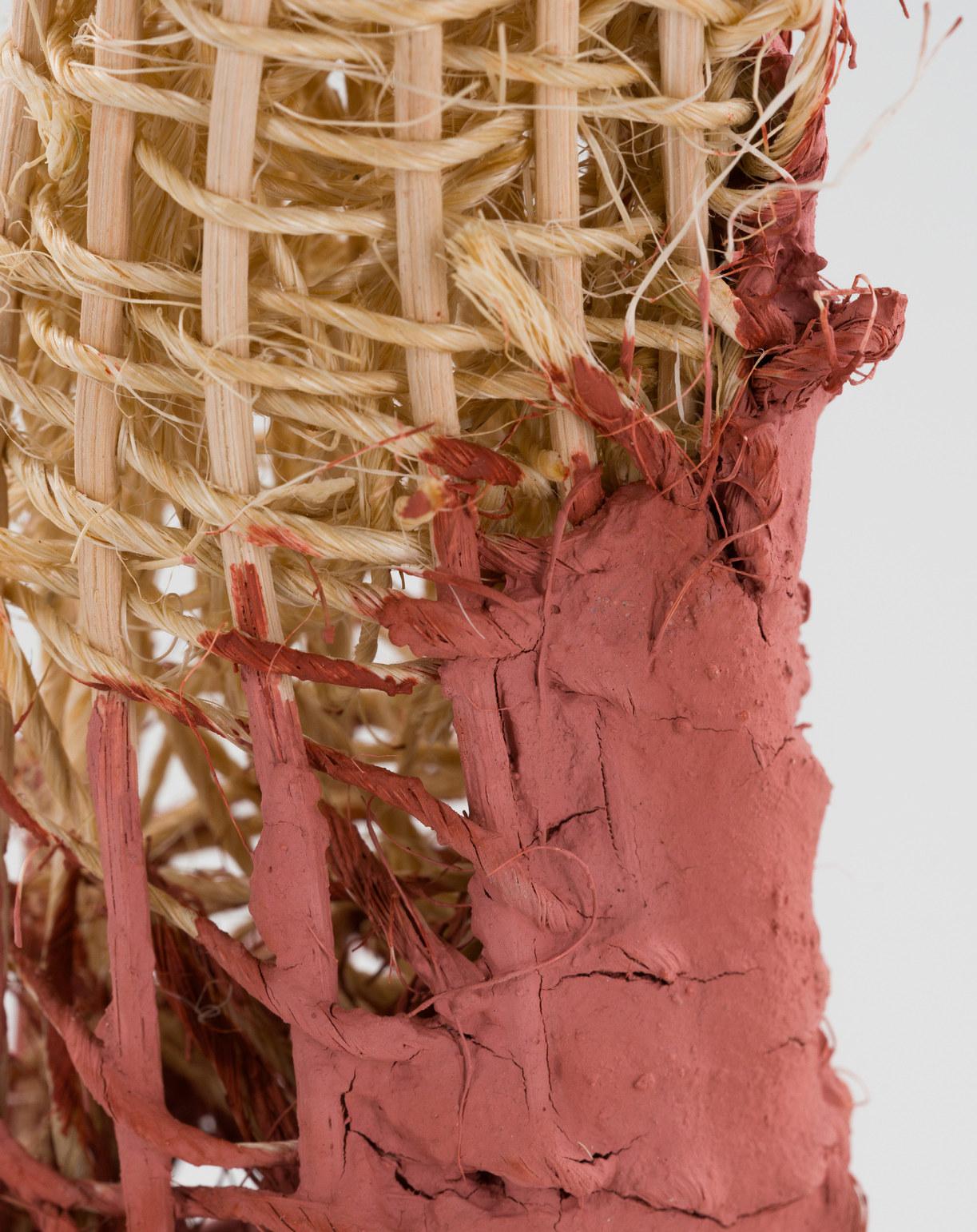

The Little Hut Sisal rope, rattan,clay
Weaving
9” x 4” x 2”
2023




GENTLE STRUCTURES
As a natural progression from exploring Maternal Constructions, I found myself contemplating how my earlier examples of spatial containers were relatively small in scale, almost resembling models of ideas in my mind. In my endeavor to scale up, I revisited the principles I had established for myself: womb, cave, hut, tent, and considered which ones could be combined to recreate the sculptures on a larger, humanscale proportion.
In this journey, the womb, created through coiling, the tent, crafted using a technique called sprang, and the grid, crafted using basketry, were my initial instincts. In these new structures, I convey more directly the dualities of flexibility and strength. Therefore, each piece embodies dual characteristics, ranging from coiling to basketry, from coiling to sprang, or from weaving to clay.
In this way, I merged my lexicon of feminist and maternal constructions to create these new “gentle structures” that encapsulate the values I sought for the pieces. Continuing the discourse on shelter, water, tension, grid, womb, cave, hut, and tent, these final structures embody the principles I delved into, while also defining new characteristics that were essential to the final pieces. Transformation, symbiosis, generosity, and nurturance were among the key principles I integrated into the creation of these largescale sculptures.
























BOUNTIFUL SHELTER FROM ROCK TO WATER
Transformation of matter from rigid to flexible.
Generosity portrayed through its volume, sinuous shapes, and curves.








SYMBIOSIS MOTHER CAVE
Parental symbiosis, providing safe and structured grounds.
Nurturing qualities, shelter, and warmth.


Mother Cave
Sisal rope, cotton rope, peaflower, clay
Weaving / Natural dyes
60” x 22” x 18”
2023


Mother Cave (Detail)
Sisal rope, cotton rope, peaflower, clay
Weaving / Natural dyes
60” x 22” x 18” 2023

Bountiful Shelter
Sisal rope, hemp twine, rattan, peruvian “junco”
Coiling / Basketry
55” x 20” x 8”


Bountiful Shelter (Detail)
Sisal rope, hemp twine, rattan, peruvian “junco” Coiling / Basketry
55” x 20” x 8”




Symbiosis (Detail)
Sisal rope, peruvian alpaca yarn, clay, bio resin, red sand, ochres
Coiling / Sprang / Natural dyes
28” x 23” x 26”
2023



From Rock to Water
60” x 18” x 7”
2023
Rattan, japanese ramie, indigo, himalayan rhubarb, bio resin
Coiling / Basketry/ Sprang / Natural dyes

From Rock to Water (Detail)
2023
Rattan, japanese ramie, indigo, himalayan rhubarb, bio resin
Coiling / Basketry/ Sprang / Natural dyes
60” x 18” x 7”
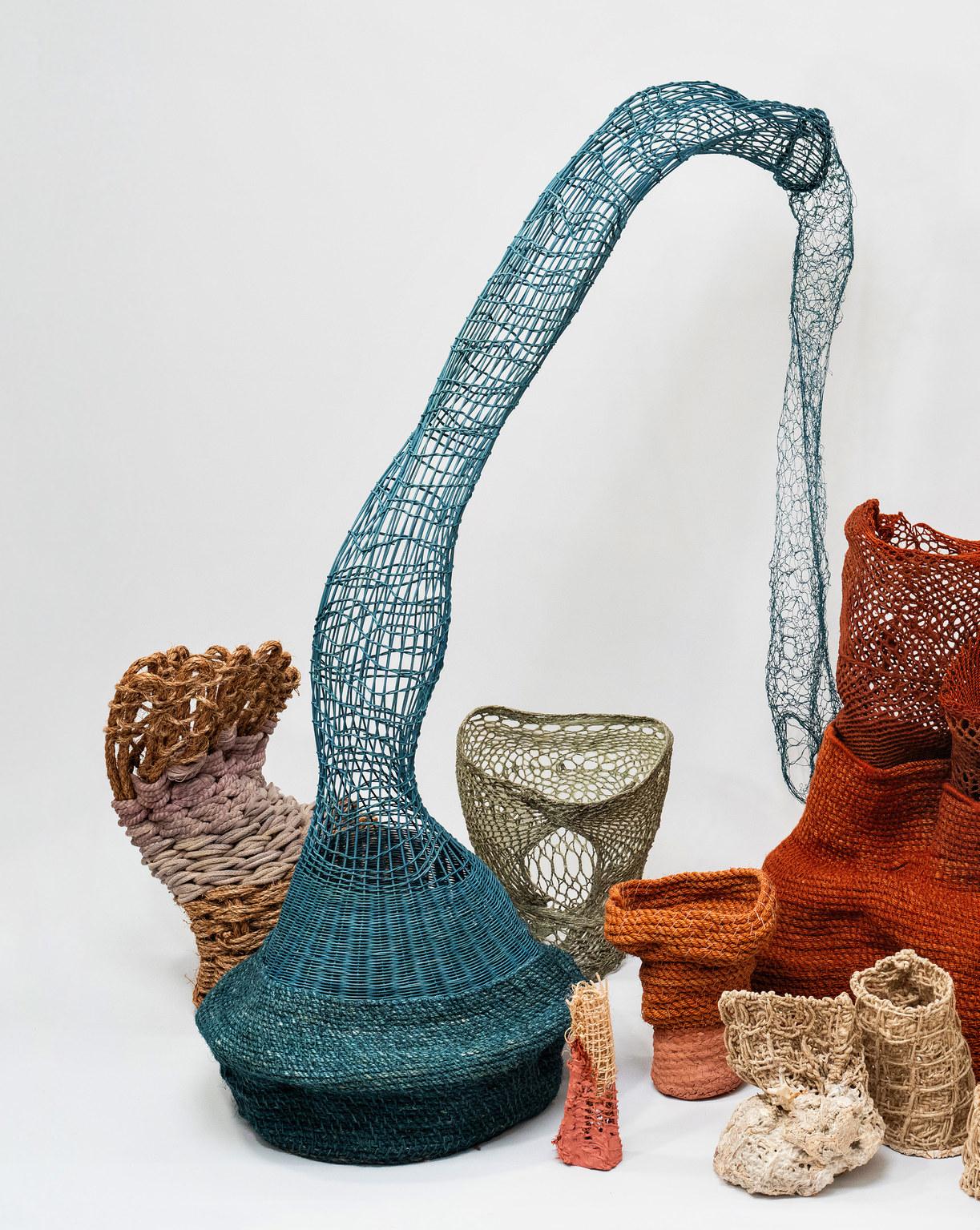


MATERIALS
VEGETAL
Reed, Peruvian “junco”, sisal rope, hemp twine, Japanese ramie.
Natural dyes such as Indigo, peaflower, catechu, madder and marigold.
ANIMAL
Peruvian alpaca yarn, silk organza, algae resin
MINERAL
ochres, red sand
FUNGI
Clay,
Mycelium

Vegetal Fibers
Carrizo, sisal rope, hemp twine, coconut rope, rattan, peruvian “junco”, manila rope

Protein Fibers
Peruvian alpaca yarn, naturally dyed

Minerals Clay, ochres from different geographical points


TECHNIQUES
WEAVING
Warp and weft structure using a tapestry frame or floor loom.
COILING
Rope in concentric circules sewn together to create volumetric structures.
SPRANG
Ancient weaving technique using only warp that intertwines itself. Predates knitting.
BASKETRY
Wet reed or junco fibers interwoven to create a tridimensional form.
NATURAL DYES
Natural powder dyes derived from plants boiled in water to create a dye bath that impregnates fibers with color.

Basketry Rattan, junco






































































































































































Natural Dyes
Marigold, peaflower, madder, catechu, avocado pits, indigo

Coiling
Sisal rope, peruvian alpaca yarn, indigo



MANIFESTO
Make intuitively and without judging yourself.
Know yourself through your work.
Reconnect to yourself through your hands.
Let your work be a reflection of your feelings, your society, your trauma, or love.
Understand the movement of rock and the stillness of water.
Speak your points of view through shape.
Make space for others.
Occupy space even if you need to demand it.
Learn from nature to be unexpected, and unplanned, to have a solid point of view but be willing to change, to be flexible, to get old or not.
Understand we are one with nature as we are born from water and die to become dust.
Take color from plants and soils.
Speak your memories through color.
Use natural materials from the places you have inhabited.
Protect people as if you had made them.
Understand the vulnerability of being alive and be patient.
Be original even if people don’t understand it.
Pour your heart into your making even if it hurts.
Touch and experience the material, the roughness of the rope, the slippery feeling of wet clay through your fingers, the smell of the wet reed, and the softness of the yarn.
Put a bit of your soul into everything you make with your hands.
Most importantly, just make.
Make with your hands like it is the only thing you want to do with your life, make so you feel alive, so you connect with the world around you. Make because we are in this world to create, to build things with emotion, to be kind to each other, to nurture strangers and lovers alike. I believe in a world where creative female energy wins over aggression and violence, where creation prevails over destruction.
So, occupy space, lead with strength and courage of conviction, be true to your hands, and just make.
























ACKNOWLEDGMENTS
This book marks the culmination of a journey that has been a pivotal stage of my life. I would like to express my gratitude to everyone who has supported me along this path.
First and foremost, I want to thank my beloved husband, Samuel. Your unwavering love and support have been my rock not only throughout this project but throughout life’s entire journey. You are my source of peace and strength, and I am endlessly thankful.
I want to thank my family—Alfonso Maldonado, Maria Angela Morales, Melisa Maldonado, and Angelina Maldonado—your constant support and enduring belief in me have shaped the person I am today. You are my eternal guiding light, and I am forever grateful.
A profound thank you to my newfound sisters, Julieta Gaitan, Nikita Jain, and Neha Bhide, whose infectious laughter, boundless wisdom, and unyielding optimism have enriched my life beyond measure, leaving an indelible mark on my heart.
I have special gratitude to my remarkable mentors and teachers—Anette Millington, Travis Fitch, Preeti Gopinath, Gabi Asfour, Layla Klinger, Victoria Manganiello, Alex de Voogt, Elodie Blanchard, and Ragna Froda, from Parsons School of Design — who shared their vast knowledge with passion, enthusiasm, and endless energy.
I am hugely indebted to Luand Gonzales for his steadfast support during my studio endeavors and to Jason Greenberg for his exceptional photography, without which this book would not have been possible.
I would like to express my appreciation to my wonderful friends and classmates Liyuan Dai, Shao – Chi Lin, Jeanna Young, Yu-Jei Yen, Mehak Surana, Aneri Shah, Zhemiao Kang, Yuchan Tu, Ji Young Kim, and Mengting Ouyang, who inspired and accompanied me at the wonderful studio space.
Parsons School of Design - The New School
MFA Textiles Gen 5
New York
Photograph Credits: Jason Greenberg, Melisa Maldonado

